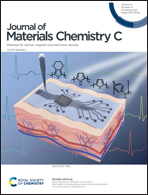The role of orientation in the MEL response of OLEDs†
Abstract
Magneto electroluminescence (MEL) is emerging as a powerful tool to study spin dynamics in organic light emitting diodes (OLEDs). The shape of the MEL response is typically used to draw qualitative inference on the dominant process (singlet fission or triplet fusion) in the device. In this study, we develop a quantitative model for MEL and apply it to devices based on rubrene, and three solution processable anthradithiophene emitters. The four emitters allow us to systematically vary the film structure between highly textured, poly-crystalline to amorphous. We find significant diversity in the MEL, with the textured films giving highly structured responses. We find that the additional structure does not coincide with energy anti-crossings, but intersections in the singlet character between adjacent states. In all cases the MEL can be adequately described by an extended Merrifield model. Via the inclusion of charge injection, we are able to draw additional information on underlying physics in OLED devices.



 Please wait while we load your content...
Please wait while we load your content...
